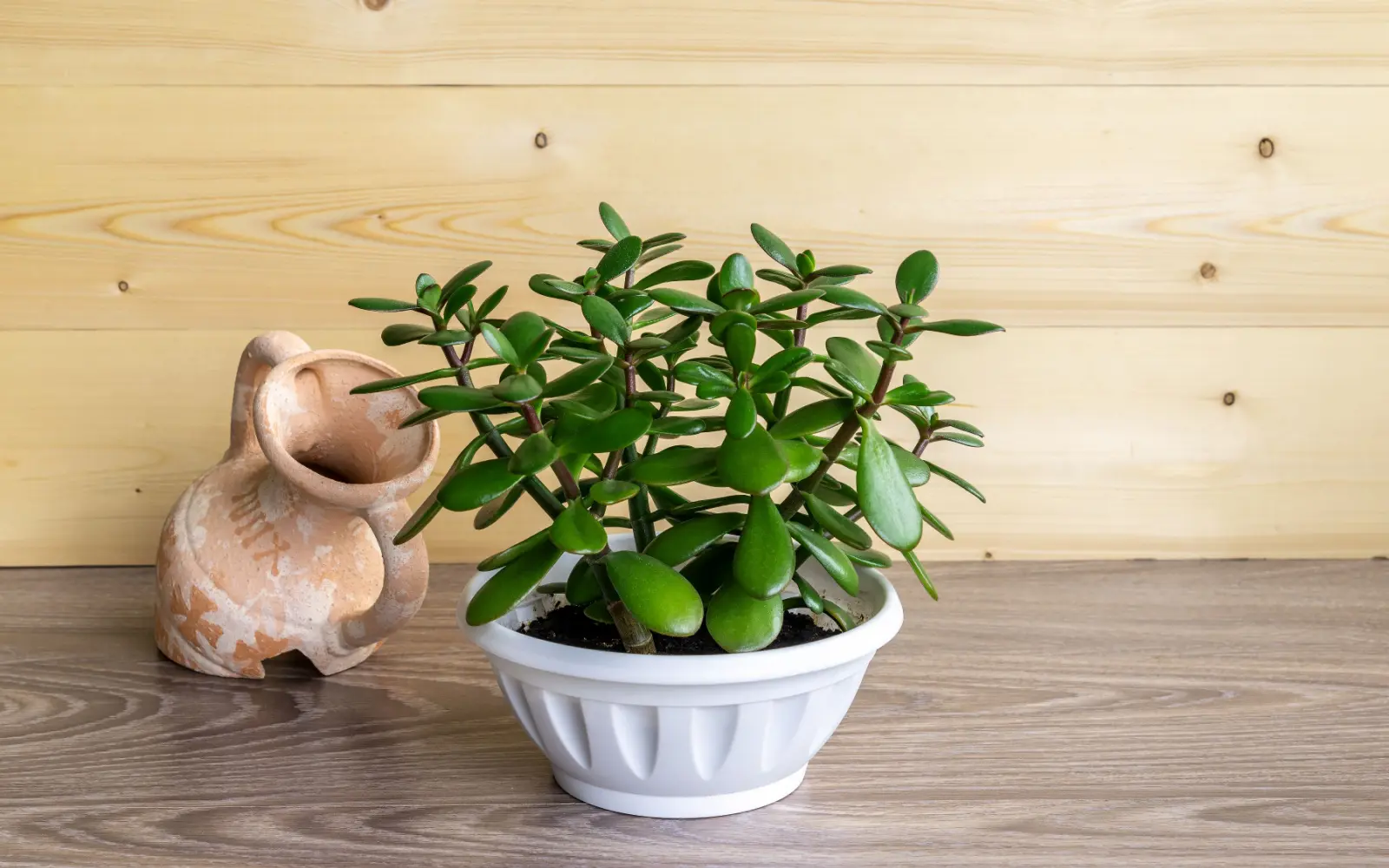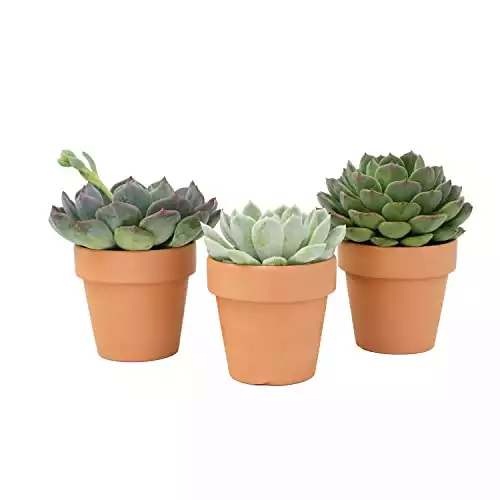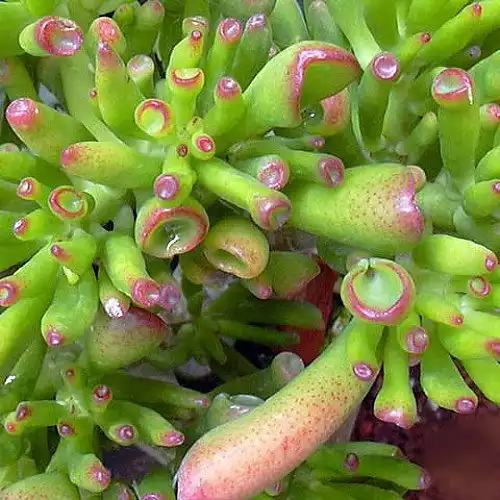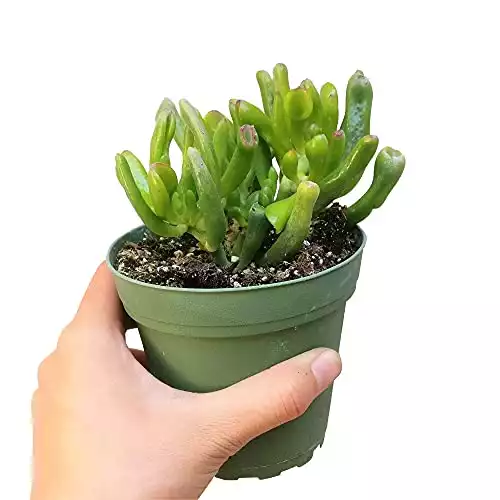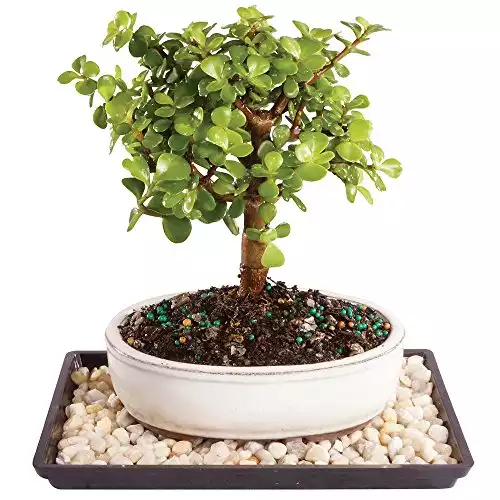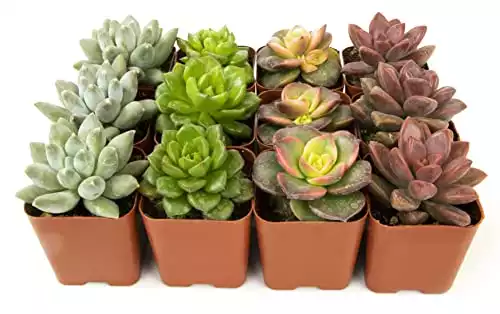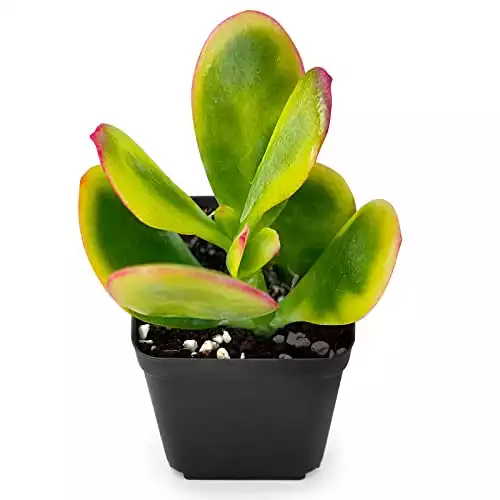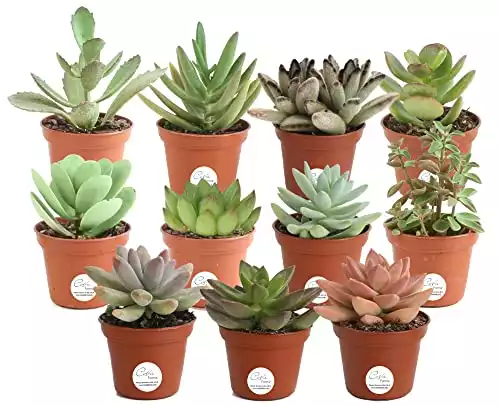Jade plants are succulents from the crassula ovata family, native to South Africa. These types of jade plants are diverse and suitable for indoor and ornamental gardens.
Whether a beginner indoor botanist or an avid gardener, jade or money tree plants are wonderful plants to add to a collection. These seven types of jade plants are the best.
Reasons Why These Types of Jade Plants Are Popular
Jade plants are easy to care for and propagate. They help improve humidity in our homes. The variety of jade plants makes them popular additions to any home or office.
Loved for many reasons, jade plants are a great addition. Here’s why.
- Low maintenance
- Choice of shapes and colors
- Flowering
- Steeped in cultural traditions and oriental art
- Symbolizes good luck and fortune
- Attractive plant
Jade Plant Types and Their History
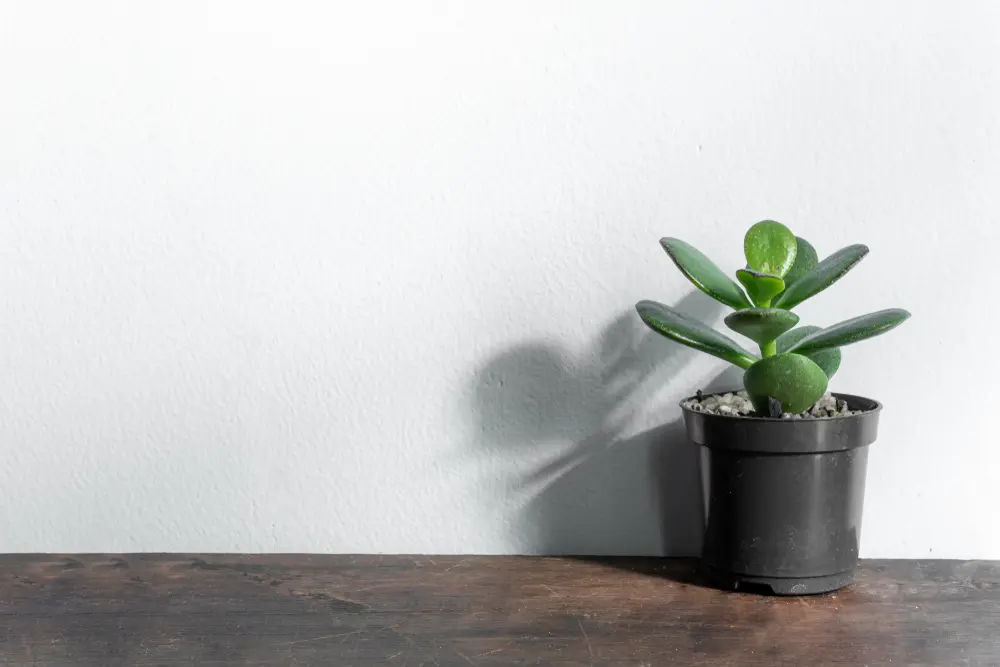
Anthony Paz/Shutterstock
Jade plants and bonsai trees have a long history in folklore and traditional Chinese culture. A jade plant is an auspicious gift that bears prosperity. The jade bonsai is an iconic symbol representing harmony, balance, and patience.
Any type of jade plant can live for many decades and become part of the family. This enduring evergreen has thick stems and waxy, shiny leaves. Jade plants, or dwarf jade (different plant species), are small trees that can grow to 10 feet in perfect conditions.
Jade plants have a strong association with Zen Buddhism, meditation, and contemplation. They’re the perfect addition to minimalist or bohemian décor.
Chinese culture considers the money tree to be a holy tree. Jade trees found in ancient Chinese tombs (206 BCE–220 CE) revealed how valuable these plants were to the culture.
This tradition is evident today, as it remains one of the most popular gifts during the Chinese New Year.
1. Silver Dollar Jade
Everyone’s seen this succulent plant for sale at the supermarket or in people’s homes. Its botanical name is crassula arborescens.
A common name is Blue Buddha Bush. While most people believe this plant is tiny, it is sold that way in small terracotta pots.
In its natural environment, when not restricted by the container size, it matures into a 24-inch-tall plant. The silvery blade leaf has a distinct burgundy edge. It blooms in the winter and requires little care.
This Silver Dollar Jade works well when planted on its own or in groups. They look great on a decorative plate or inside a glass bowl for a more dramatic effect.
2. Gollum Jade
Yes, it’s named after Tolkien’s character and is part of the Tolkien group of succulents. Its botanical name is crassula ovata, Gollum.
Its clustered tubular leaves resemble a finger with a red ring on the tip. This jade has the classic look of a bonsai tree.
Other names include Trumpet Jade, Hobbit’s Pipe, Money Tree, and Spoon Jade. It’s famous for its unique Tolkien association and appearance. In the right conditions, it can grow up to 3 feet.
It blooms with white, star-like blossoms in late winter and early spring. What makes this jade so appealing is its sparse branches and its versatility. Gardeners or hobbyists can shape it into a symbolic tree or a dense bush ground cover.
3. Variagated Gollum Jade
With its verdant green and white-striped tubular leaves, the variegated version is a complimentary jade to the red-rimmed Gollum jade. The variegated tips of the leaves often have an orange hue and red tips, with white striping.
Variegated simply means multiple colors, although green and white are prevalent. Like all succulent plants, the Varigated Gollum Jade requires minimum care.
A full sun window or garden plot, the right temperature, a bit of fertilizer, and the variegated jade will thrive. Overwatering is fatal to gollum jade and other succulents. It grows successfully in hardiness zones 10a to 11b.
Like its cousin, it can grow up to 3 feet or spread low to the ground with training. Its orange-reddish tip and yellowish-green tubular leaf make this version particularly attractive as an ornamental Bonsai.
4. Common Jade Plant
Crassula ovata belongs in every home gardener’s and indoor plant enthusiast’s collection. This popular type of jade has tear-drop-shaped leaves.
The common jade has many nicknames: Chinese Rubber, Dollar Plant, Dwarf Rubber Plant, Friendship Tree, Lucky Plant, Pink Joy, and Jade Plant.
The Common Jade can grow over 8 feet tall in the right gritty soil conditions. It will bloom if it gets enough direct sunlight and moderate watering.
The singular trunk can get up to 8 inches in diameter. The plant blooms in clusters with white or pink star-shaped flowers. Dwarf Bonsai variants are perfect for homes or office spaces.
For a healthy jade plant, provide at least 4 to 6 hours of direct sunlight and supplement the soil or potting mix with perlite or pea gravel and a hint of fertilizer.
It doesn’t like water-retaining compounds. Many people mistake the scar tissue on the trunk as a sign of illness. It’s part of the plant’s natural progress during leaf shedding.
5. Botany Bay Jade
This jade is the new kid on the block. Cultivated only since 2011, the Botany Bay Jade is another jade often sold as miniatures in the local supermarket. Its semi-flat, spoon-like leaves have a distinct red rim and a silvery green sheen.
It grows into a compact, bush-like shrub if given ample space. A botany bay is very forgiving of neglect and prefers dry conditions. It rewards its keepers with pretty star cluster flowers in delicate shades of pink and white.
This plant makes a great garden partner for succulents or cacti with similar watering needs.
If left to thrive in a suitable-sized container, it can grow over 3 feet in less than 5 years. The size of the container affects Botany Bay’s plant size, like many succulents.
6. Hummel’s Sunset
Award-winning crassula ovata Hummel’s Sunset took home the Royal Horticultural Society award in 1993 for its stunning ‘sunset-like’ foliage. It is still a well-known jade that horticulturist Ed Hummel cultivates under the name “Golden Jade Tree.”
He has received awards and fellowships for his contributions to the development of succulents. Hummel’s Sunset is an attractive succulent with a vibrant display of color.
Its thick trunk often has more than one stem and can grow over 3 feet in the right conditions. Hummel’s Sunset is an evergreen that blooms with stunning white star flowers in late fall and early spring.
This jade plant is a versatile garden or indoor plant. It thrives in rock gardens and sandy, even poor, soil and is easily grown. A Hummel’s Sunset looks beautiful in a staggered pot arrangement.
7. Calico Kitten
For anyone who has a desire for a showstopper jade plant, the Calico Kitten is the one. This stunning jade is often hard to find online. Crassula Marginata Variegata is a unique addition that requires minimum care.
The Calico Kitten has a unique color combination. The heart-shaped leaves have a green center and a white or yellowish band. The hot or rosy pink rims set this plant apart.
A key element to remember when ordering any jade plants online is that it takes time for the plant to establish itself in its new surroundings. It might not grow into its natural shape and look for some time.
Using beautiful jade plants in indoor ceramic pots adds an element of organic décor. Since Calico Kitten jade plants only reach about 6 inches in height, consider companion planting them with similar-sized jade plants.
Taking Care of Jade Plants
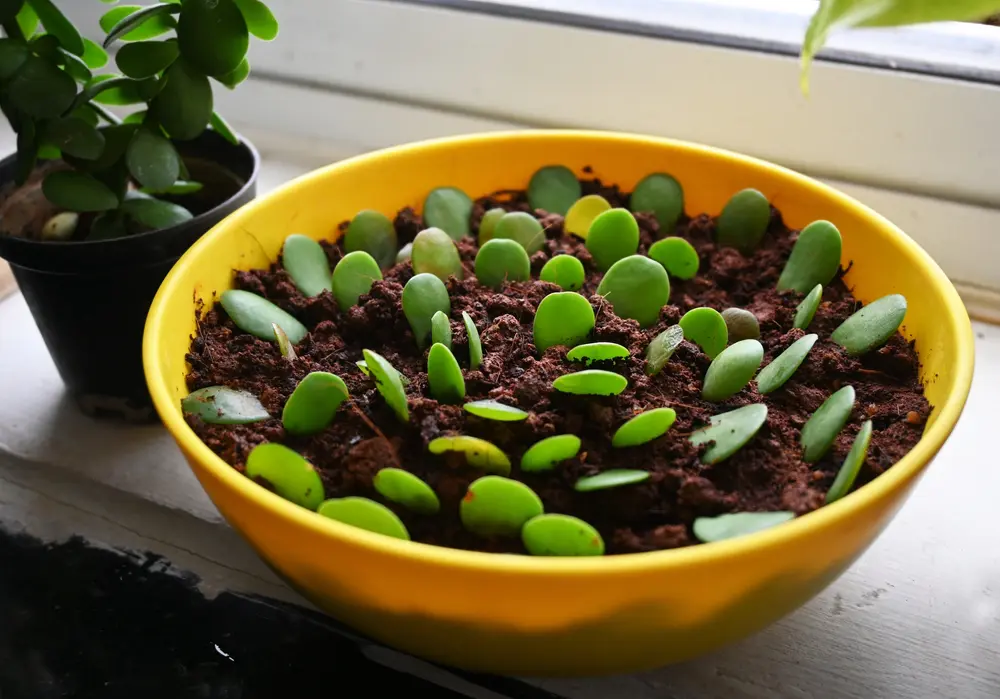
Shruti Sreya Satpathy/Shutterstock
Jade plants are easy to care for and benefit your homes and lives. Planting succulents in well-drained potting soil is ideal.
General tips:
- Use premixed potting soil for succulents and cacti
- Use a 2:1 ratio of potting soil and perlite
- Provide 6 hours of indirect sunlight for seedlings
- Mature plants thrive in full sun
- Keep at ambient indoor temperatures of 65 to 75 F (overnight to 55 F)
- Plant in moderate depth
General don’ts:
- Don’t water right after planting or repotting (wait 1 week to a month)
- Avoid using highly saline water
- Don’t overwater; instead, focus on bi-monthly
- Plant outside in hardiness zones below 10a to 11b; not frost-tolerant
- Don’t wet the leaves
Spring and summer maintenance requires infrequent watering. Look for soil that is dry before adding water. Avoid surface watering. Fall and winter requirements are different.
Some plants may go dormant and require very little water. Your plant might need more water if you notice shriveled leaves or brown spots. Soggy leaves and squishy stems mean overwatering; it’s the number one jade plant killer.
Jade plants benefit from repotting, though they don’t mind being rootbound. Repot younger plants every 2 to 3 years. Mature plants benefit from repotting every 4 to 5 years.
Pests and Diseases
Jade plants have few enemies besides overwatering. Indoor plants may grow powdery mildew. Treat the condition with this mixture in the morning, and allow the leaves to dry.
Root rot is a common problem for succulent keepers who overwater. Allow the soil to dry completely. Wrinkled or shriveled leaves mean your plant is thirsty. Water deeply. Waterlogged, squishy leaves, or shedding are symptoms of over-watering.
Trunk scarring when the leaves fall off is a natural occurrence in jade plants. Taller varieties without dense leaves protect it more obviously. These minor and preventable problems can affect any type of jade plant.
Frequently Asked Questions
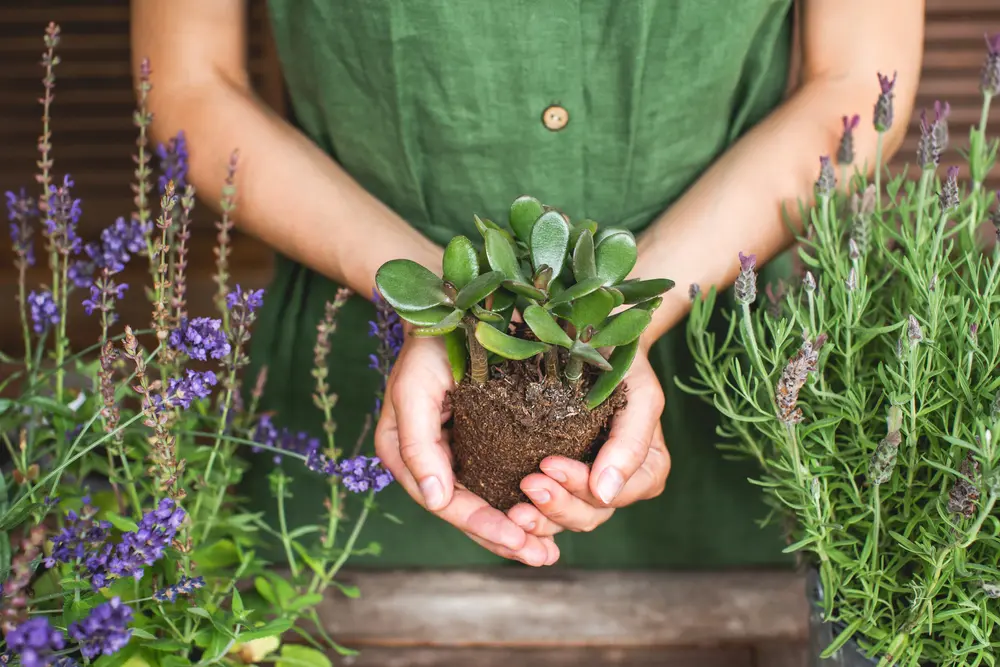
Krichevtseva/Shutterstock
Adding houseplants is beneficial to our well-being. They help provide humidity and clean the air. They also bring us joy when they thrive and bloom.
Are jade plants poisonous to dogs and cats?
Jade plants are harmful to pets. Keep them out of reach. Symptoms include vomiting, diarrhea, drowsiness, or lethargy. Consult your veterinary.
What’s the difference between succulents and cacti?
Succulents and cati are cousins. Cacti have needles on their spines. These needles are sometimes very visible or fine, like hair. Cacti absorb and hold water in their stem; most don’t have leaves. Succulents absorb water and nutrients in their leaves. Both can produce flowers.
Is there more than one type of jade plant?
Worldwide, there are over 1,400 types of jade plants. They are grown indoors and in gardens with moderate climates.
Do all jade plants bring good luck?
Jade plants have a long association in some cultures with bringing good luck and fortune to the recipient.
How much light does a jade plant need?
Jade plants need about 6 hours of direct sunlight to thrive. Immature plants can’t tolerate scorching heat.
Are jade plants lucky?
Jade plants have a cultural reputation for bringing good luck and fortune to those who keep jade plants. It’s symbolic of growth and renewal.
What Is the Best Type of Jade Plant?
Crassula ovata is the true jade species; some are rare and expensive. It’s sometimes confused with Portulacaria afra, the dwarf jade.
Jade plants make a lovely addition to any décor; choosing one over the other is a personal choice. Any type of jade plant will bring years of joy to its keeper.

